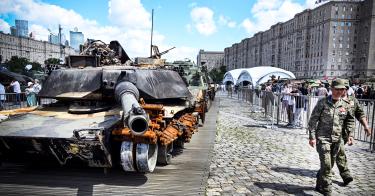Since the Russian invasion of Ukraine over two years ago, politicians advocating for more U.S. taxpayer assistance to Ukraine have claimed we’re bleeding Russia dry at a comparatively small cost. But when it takes a million-dollar American missile to knock out a thousand-dollar enemy drone, it looks more like we’re the ones bleeding out—suggesting maybe we should quit the world-policeman racket.
That’s doubly true given our most daunting national security challenges are the rise of China and the collapse of security at the border.
Neocons like Sen. Lindsey Graham, R-S.C., have called the more than $175 billion we've poured into the Ukraine meat-grinder "the best money we've ever spent,” despite there being no articulated American goal in the conflict against which to evaluate that claim.
The original Biden-Harris premise of our involvement in the Ukraine was that we must exhaust Russia to get to victory, although it was never clear precisely how or why. The ruthlessness of the Russian strongman Vladimir Putin is not a logical justification given the atrocities committed by countless dictators around the world, and the existence of far worse humanitarian disasters in places like the Democratic Republic of The Congo.
Regardless, it’s never been articulated precisely why the average American family should care who runs the Ukrainian city of Donetsk, especially with existential security issues on our wide-open southern border and a burgeoning Chinese military. Yet even if bleeding out Russia can be established as a national security issue worth over $175 billion, is that what’s actually happening? In a word, no.
What the Ukraine conflict has definitively shown us is that the economics of modern war have changed, perhaps forever.
Footage recently emerged of $35,000 Russian Lancet drones taking out $10-million Abrams tanks and $5 million HIMARS. Similarly, the Houthi drones in Yemen being launched against Western shipping cost $20,000 while the surface-to-air missiles intercepting them cost as much as $4.5 million. That’s a ratio of more than 100-to-1.
But that’s just America’s cost to build these weapons. It's fantastically expensive to transport them around the world too. Transporting a tank to the Ukraine is at least several hundred thousand dollars, and the cost of sending a guided-missile destroyer to meander around the Red Sea lobbing $2 million missiles is about $70 million per year—not including the missiles.
And the spectacular cost in the Red Sea hasn’t had much impact judging by insurance costs for Red Sea transit, which haven’t improved much. Furthermore, American ships don’t usually traverse the Red Sea; they use the Atlantic and Pacific Oceans instead. We’re spending millions to protect the shipping interests of Europe and China, both of whom use this lane to keep access to each other’s markets.
The carrier battle group we’re sending as a show of force in the region is costing $7 million per day—about $2 billion per year—against much more cost-effective, newer drone technology. Perhaps the world-policeman role is bleeding out the policeman.
We’ve been here before. In 1906 the U.K. launched HMS Dreadnought. She was a revolution in battleship design, to the point that all ships before and after her became known as either pre-dreadnoughts or dreadnoughts. But instead of conferring permanent dominance upon the Royal Navy, Dreadnought bankrupted it.
Because those obsolete pre-Dreadnoughts, it turned out, were largely British. The U.K. has obsoleted its own military, yielding global dominance to the U.S., who with superior industrial might, could send more dreadnoughts down the slipways. The collapse of American industrial might vis-a-vis China now poses a similar challenge.
Given the dramatic scale of Chinese military expansion, the United States will have to husband its resources far more carefully than it has been. The U.S. has wasted many trillions of dollars in Iraq and Afghanistan, ignoring the return of great power competition.
American policymakers must resist the temptation of using the military everywhere. They should instead focus scarce American resources on the most pressing national security challenges to the American people, including the threat posed by the cartels at the border.
A more cost-effective strategy might be to stop being the world’s policeman at a disproportionate cost to U.S. taxpayers and prioritize protecting our own national security interests instead.
This piece originally appeared in MSN





